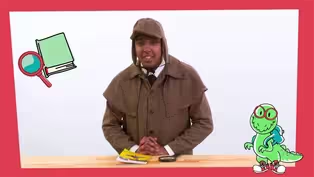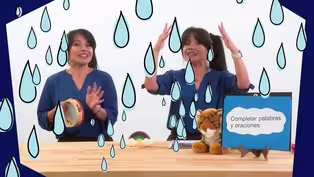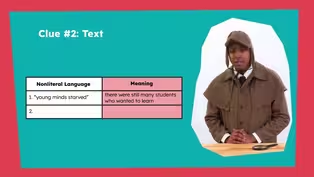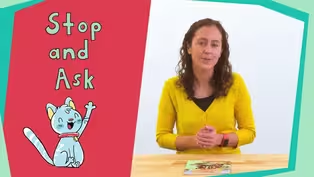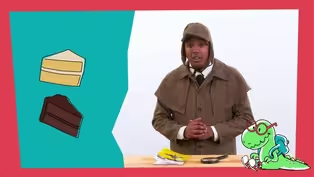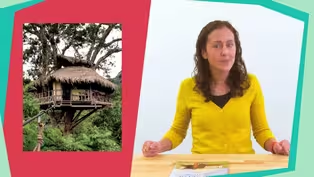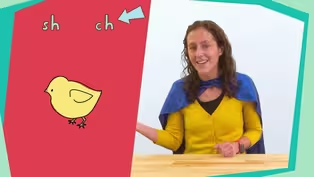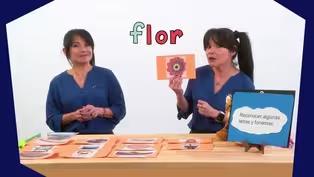
Episode 44 | Literacy Lessons
5/11/2021 | 28m 45sVideo has Closed Captions
LIteracy lessons for early learners, led by NC teachers.
In the first lesson (aimed at 3rd graders) learners will learn how to identify key details to support the moral of the story. The second lesson (aimed at 1st-2nd graders) students learn how to blend words based on sounds. Classroom Connection is your At-Home Learning companion where children love to learn. All lessons are led by NC educators.
Problems playing video? | Closed Captioning Feedback
Problems playing video? | Closed Captioning Feedback
At-Home Learning Presents: Classroom Connection is a local public television program presented by PBS NC

Episode 44 | Literacy Lessons
5/11/2021 | 28m 45sVideo has Closed Captions
In the first lesson (aimed at 3rd graders) learners will learn how to identify key details to support the moral of the story. The second lesson (aimed at 1st-2nd graders) students learn how to blend words based on sounds. Classroom Connection is your At-Home Learning companion where children love to learn. All lessons are led by NC educators.
Problems playing video? | Closed Captioning Feedback
How to Watch At-Home Learning Presents: Classroom Connection
At-Home Learning Presents: Classroom Connection is available to stream on pbs.org and the free PBS App, available on iPhone, Apple TV, Android TV, Android smartphones, Amazon Fire TV, Amazon Fire Tablet, Roku, Samsung Smart TV, and Vizio.
Providing Support for PBS.org
Learn Moreabout PBS online sponsorshipMore from This Collection
Video has Closed Captions
Literacy lessons for early learners, led by NC teachers. (28m 46s)
Video has Closed Captions
Literacy lessons for early learners, led by NC teachers. (28m 46s)
Video has Closed Captions
Literacy lessons for early learners, led by NC teachers. (28m 45s)
Video has Closed Captions
Literacy lessons for early learners, led by NC teachers. (28m 45s)
Video has Closed Captions
Literacy lessons for early learners, led by NC teachers. (28m 46s)
Video has Closed Captions
Literacy lessons for early learners, led by NC teachers. (28m 46s)
Video has Closed Captions
Literacy lessons for early learners, led by NC teachers. (28m 45s)
Video has Closed Captions
Short Description: Literacy lessons for early learners, led by NC teachers. (28m 45s)
Video has Closed Captions
Literacy lessons for early learners, led by NC teachers. (28m 45s)
Video has Closed Captions
Literacy lessons for early learners, led by NC teachers. (28m 45s)
Video has Closed Captions
Literacy lessons for early learners, led by NC teachers. (28m 45s)
Video has Closed Captions
Literacy lessons for early learners, led by NC teachers. (28m 45s)
Providing Support for PBS.org
Learn Moreabout PBS online sponsorship[cheerful upbeat music] ♪ - When I was reading today about outer space, I read that one million Earths could fit inside the sun.
That's a really big sun.
But it looks so small from Earth 'cause it's so far away.
I love outer space.
What's your favorite thing to read about?
We have a awesome literacy lesson for you today, so watch out 'cause here it comes.
- Hi everyone, it's Ms. Shakemia back again and looking forward to learning even more with you today.
When recounting stories, we identify the main character and setting, retell the events of the story in chronological order and identify a central message or moral of the text.
Today, we're gonna read the fable "The Wind and the Sun" and focus on explaining how the central message or moral is conveyed through key details in the text.
Let's do a quick refresher.
I want you to tell me what the moral of the story means, but I want to give you some time to think first.
I'm going to count down from 10 and say go.
When I say go, you're going to tell me what the moral of the story means as loud as you can.
I want you to try to blow me away like that aggressive and forceful wind we will read about today.
Do you think you can do that?
Great.
Remember, don't say it until I say go.
Start thinking now.
10, nine, eight, seven, six, five, four, three, two, one, go.
Whoa.
You guys are way stronger than the wind.
Yes, the moral of the story is the lesson learned from a story or an experience.
Awesome job.
As we dig into explaining how the central message or moral is conveyed through the details in the text, I'm going to provide you with the moral of "The Wind and the Sun".
Then we're going to read the story and find key details in the text to support our thinking about the moral.
In "The Wind and the Sun" our main characters, Wind and Sun, are chatting in a park on a beautiful day about who is stronger.
They decide to have a competition to determine who is the strongest.
The sun ends up winning the competition.
And through the sun's winning approach to the competition, we learn that the moral of the story is it's much easier to persuade someone to do something by being gentle and kind.
Now, we need to read our story to find key details that support our thinking on this moral.
What makes something a key detail?
Well, a key detail is an important part of the story.
In this case, any detail that supports our thinking about the moral is very important.
Time to jump into our story.
I want you to read with me today and as we're reading, I want you to be on the lookout for any key details that support the moral of the story.
Are you ready?
Let's begin.
One beautiful day in the park, the sun and the wind were having a chat.
The wind boasted, "I am so much stronger than you."
The sun just smiled politely, but did not say a word.
"Since you don't believe me, let's have a competition to see who's stronger," said the wind, flexing its muscles.
The sun reluctantly nodded his head in agreement.
At that moment they saw a man wearing a jacket out for a stroll, a very slow walk, to get some fresh air.
The wind said, "Whoever can make the man remove his jacket first is stronger."
The sun agreed and told the wind to take the first turn.
The wind blew with all of his might, began to blow and blow.
The man gripped his jacket tighter and tighter.
The wind continued to blow, harder and harder, but the stronger the wind blew, the tighter the man held onto his jacket.
The wind blew until his cheeks were on fire, but ultimately couldn't remove the jacket from the man.
Next, it was the sun's turn.
At first, the sun smiled warmly and its rays beamed very gently on the man.
The man started to feel a bit warm and began loosening his grip on the jacket.
As the sun went on smiling, shining brighter and brighter, the man felt warmer and warmer.
Finally, he took off his jacket.
The wind whirled in defeat and the sun simply continued to smile warmly, not saying a word.
That was really great reading.
Did you notice any key details?
Great, I found some, too.
To keep track of our key details today, we're going to add them to our graphic organizer.
On our graphic organizer, you can see that we're going to be identifying three key details from the text that support our moral of it's much easier to persuade someone to do something by being gentle and kind.
There are definitely more than three key details in the text that support our moral for "The Wind and the Sun".
Keep in mind that the key details you identify in any text could differ from those someone else finds to support the moral.
The important thing is that you are able to explain your thinking as to how the key details support the story's moral.
Watch me as I read paragraph two and look for key details that show the wind did not act gently or kind toward the man.
The wind, with all its might, began to blow and blow.
The man gripped his jacket tighter and tighter.
The wind continued to blow, harder and harder, but the stronger the wind blew, the tighter the man held onto his jacket.
The wind blew until his cheeks were on fire, but ultimately couldn't remove the jacket from the man.
In the second paragraph, I noticed that the wind was being very aggressive while trying to blow off the man's jacket.
The text says, "The wind blew until his cheeks were on fire."
This tells me that he was trying very, very hard to force the man's jacket off.
I'm going to add this to my, this key detail to my graphic organizer in the spot for key detail number one.
In my graphic organizer, I always include what the detail is and where in the text I can go to reference my thinking.
Now, I want you to find a key detail in the third paragraph to support how the sun was being gentle and kind towards the man.
We'll reread paragraph three together and when you notice a key detail, I want you to flash your fireworks, just like this.
Are you ready?
Let's go.
Next, it was the sun's turn.
At first, the sun smiled warmly and its rays beamed very gently on the man.
The man started to feel a bit warm and began loosening his grip on the jacket.
As the sun went on smiling, shining brighter and brighter, the man felt warmer and warmer.
Finally, he took off his jacket.
The wind whirled in defeat and the sun simply continued to smile warmly, not saying a word.
Oh wow, I see lots of fireworks going off.
There were a few possible key details in that paragraph.
I'm going to share just one.
The first one that we come to as we are reading is "the sun smiled warmly and its rays beamed very gently."
So let's add that information to our graphic organizer.
In paragraph three, you also may have noticed the key detail of "As the sun went on smiling, shining brighter and brighter, the man felt warmer and warmer."
Both of these details show us exactly how the sun was behaving.
It was warm, smiling and gentle.
So, for our last key detail, we need to show whether the wind or the sun's approach won the strength competition to remove the man's coat.
Let's stay in paragraph three, although there are other key details in paragraph two that could help us, as well.
In paragraph three, who was able to successfully remove the man's jacket?
Right, the sun.
The text states that the sun continued shining and the man got hotter and finally, he took off his jacket.
The wind whirled in defeat.
So, let's add that third key detail to our graphic organizer.
Now, let's synthesize our thinking about how we know the moral of "The Wind and the Sun" is that it's much easier to persuade someone to do something by being gentle and kind.
We can write our response in the last box on our graphic organizer.
We'll begin our response with the moral, "This is the moral because" and now I'll give you a few seconds to finish the sentence.
[lighthearted music] I'm going to share my synthesis sentence with you now.
If you wrote down or thought something similar, that's great.
If your response differs from mine, then just make sure that it explains how the key details support the moral of our story.
For my synthesis, I wrote, "This is the moral because the sun's gentle and kind approach persuaded the man to remove his jacket, while the wind's aggressive and forceful approach did not."
Well, we reached our goal again.
We found key details to support our thinking today.
So, you know what that means.
It's celebration time.
On three, I want you to kiss your brain.
One, two, three.
Great job.
Today, we took the moral from our story and revisited the text several times to find key details that supported our thinking.
You not only shared your thinking, but you proved why your thinking is valid and showed how you arrived at your answers.
Remember that it's important to revisit each text that you read several times to gain deeper understanding.
I had so much fun with you today and I hope you enjoyed growing your brain as much as I did.
See you next time, have an awesome day.
- That was great.
There are so many awesome ways to use words.
What are some of your favorite words?
- Hi, my name is Ashley and I'm an educator here at Sylvan Heights Bird Park in Scotland Neck, North Carlina and today I'd like to introduce you to one of our education ambassadors.
This is a Harris's hawk.
Harris's hawks are part of the birds of prey family, which also includes eagles, owls and osprey.
These birds all have a few characteristics in common.
Mainly, they have some sharp, curved claws called talons, used for grabbing and gripping their prey, a sharp, curved hook beak, used for ripping and tearing their prey into small pieces to allow them to eat it easier, and they usually have muted feather colors, like blacks, browns, grays and whites.
Their are 17 species of hawks in North America, including the red-tailed hawk and the red-shouldered hawk, both of which are very common in North Carolina and Virginia.
So, Harris's hawks are actually not native to the Eastern part of the United States, you'll actually find these animals living out in the Southwestern part of our country, down into Mexico and Central America.
Harris's hawks normally live in open, dry, arid, kind of scrub-like habitats.
These guys are desert dwelling hawks.
Being birds of prey, Harris hawks primarily feed on small and medium size mammals, other birds and reptiles.
One thing that sets our Harris hawks apart from other birds of prey is the fact that they are social animals.
Most birds of prey usually like to be solitary, they like to hang out on their own.
They only come together for mating and nesting and taking care of the young for some species.
Harris hawks, on the other hand, do like to hang out in pairs or family groups.
They will nest communally and actually cooperate with other Harris hawks to hunt.
Just like a pack of wolves or a pride of lionesses, Harris's hawks will work together to sort of flesh out, tire out and take down larger prey animals.
Due to their social nature, Harris hawks are often a favorite species of bird used by falconers and as education ambassadors, like here at Sylvan Heights Bird Park.
Birds of prey are often called raptors, coming from the Latin word rapere, which means to grasp.
And that goes back to those beautiful, really strong feet with those curved claws, those talons, that they're using to grasp their prey.
Harris's hawks typically live 15 to 20 years and can have a wingspan of three to four feet in length.
Like all birds of prey species, female Harris hawks due tend to be larger and heavier than male Harris hawks.
It's a little bit backwards.
When we think of most animals, we think of the males being larger than females, but it's reversed in birds of prey, with females being larger than males.
Thanks for tuning in and joining us today.
We hope to see you here soon at Sylvan Heights Bird Park.
- Did y'all like that?
That was so cool.
Thank goodness for this time right at home.
Look, can't stop now.
Check out what we got next.
- Hello readers.
My name is Ms. Gary and I'm so excited to be learning with you today.
Before we get started with our learning lesson, let's say hello with our welcome song.
♪ Hello readers, hello readers ♪ ♪ How are you?
How are you?
♪ ♪ I'm so glad to see you, I'm so glad to teach you ♪ ♪ Hello you ♪ ♪ You and you ♪ So, let's take a look at this anchor chart.
These letters are called vowels.
Each one may make a short vowel sound and a long vowel sound.
So let's review our short and long vowel sounds.
So, I love to move.
So we're gonna learn and review our long and short vowel sounds.
I'm gonna crouch down when I say a short vowel sound and stand up when I say a long vowel sound.
So, let's do that together.
Stand up for me and get ready, readers.
Here comes the "A".
Short "A" says ah and long "A" says "A".
Here comes "E".
The short "E" says eh and the long "E" says "E".
Next is "I".
Short "I", ih, long "I","I".
Next is "O".
The short "O" vowel sound says ah and the long vowel "O" says "O".
And here's the "U".
Short "U" says uh and the long "U" says "U".
Wow, readers, that was great.
We will find these vowels in every word that we read and write.
But, in addition to knowing our long and short vowel letter sounds during each lesson, we're going to learn some special words.
The words have special names and they're called heart words.
And we call these word heart words because we're practicing reading them so that we know them by heart or so we won't have to sound them out.
To do this, we're going to create our very own heart word dictionary.
You're going to need two pieces of paper and something to write with.
While I grab mine, you go ahead and get yours.
[upbeat music] I'm back, readers, with my two pieces of paper and something to write with.
I grabbed a marker, but it's okay if you grabbed a pen or pencil or crayon.
So, let's make our heart dictionary together.
I'm going to start by stacking my two pieces of paper on top of each other, just like this.
Now, I'm going to fold them in half hamburger style, or the short way.
[upbeat music] Wow, look at that, readers, it's a book.
But, we're going to draw a heart on the cover of our heart word dictionary, so that we know we're putting our heart words there.
[upbeat music] Now we're ready, so let's read our first heart word.
Look at this word.
This is the word could.
Can you say could?
Good.
Now, let's spell it.
C-O-U-L-D. Could.
Let's say it one more time.
Could.
Now, we're going to write it on the first page of our heart word dictionary.
Let's write it.
C-O-U-L-D. Could.
And there's mine.
Great job, let's get ready for our second heart word.
Look at this word, readers.
This is the word away.
Can you say away?
Good.
Now, let's spell it.
A-W-A-Y.
Away.
Let's say it one more time.
Away.
Now, we're going to write this heart word on the second page of our heart word dictionary.
A-W-A-Y.
Away.
Great job, Readers.
We're going to learn one more heart word for our dictionary.
Let's look at this word.
This is the word they.
Can you say they?
Good.
Now, let's spell it.
T-H-E-Y.
They.
Let's say it one more time.
They.
Now, we're gonna write our final heart word on the third page of our dictionary.
T-H-E-Y.
They.
Excellent work, Readers.
Later today, you could share your heart word dictionary with someone you love or show them how you read it.
In today's lesson, we're going to learn about how vowels work together on a team and that some of the time when vowels work together side by side, only the first vowel says its letter name, like here.
So, when two vowels go walking, the first one does the talking.
So, to help us learn about how vowel teams work together in words, let's look at some of our most common vowel teams that we see in words.
Let's look at this vowel team, E-A.
[magnets clicking] Listen to me say this word.
Beach.
Let's tap out the sounds we hear in the word beach.
B, ea, ch.
What sound did you hear this vowel team say?
Normally, when we see the "E" and the "A", they say the sounds eh and ah separately, but together when we see them, sometimes they'll say the long sound "E".
So when two vowels are together, like "E" and "A" in the word beach, the first vowel is doing all of the talking.
So, when I see E-A together, what sound will it say?
"E".
Can we build some more words that have the E-A vowel team sound?
[upbeat music] We put a "R" at the beginning.
Let's read this word.
Reach.
What sound did you hear the E-A say?
"E".
So this word is reach.
Now, let's look at our next E-A vowel team word.
[magnets clicking] The D-R at the beginning of our word, that's a blend.
So when we read that sound, we're gonna go drr and blend the sound together.
There's the "E" and our final sound is mm.
So when I read it together, dr, ea, m. Dream.
Now, let's look at another pair of vowels that make the same "E" sound.
[upbeat music] Let's read this word this is the word keep.
I'll point to the letters and you say the sounds with me as I point.
K, ee, p. Keep.
The letter "K" makes the k sound, the E-E vowel team makes the long "E" sound and the "P" makes the p sound.
The E-E vowel team, when they're together, is going to say long "E", "E".
Can you say that?
Good.
Let's look at our next word with our E-E vowel team.
This is a diagraph, so when we see it, it goes th at the end of our word.
So, let's read it together.
T, ee, th.
Teeth.
This word is teeth.
The E-E together make the long "E" sound.
Let's read one more.
My S-L is a blend, so when I read it, it'll sound like this, sl.
Let's read this word.
Sl, ee, p. Sleep.
That's the word sleep.
So, the E-E together, that vowel team says "E".
Let's look at another vowel team.
[upbeat music] This is the vowel team A-I.
Together, they're going to make the long "A" sound, "A".
Let's look at a couple words that go with this vowel team.
This is the word rain.
R, ai, n. And I can change that beginning sound out to tr, and it will read train.
So, we're gonna take a look at just a couple more words that go with the vowel teams A-Y, O-A and I-E.
So, let's look at our vowel team A-Y.
[upbeat music] This vowel team, when they're together, they're going to say "A".
So, let's build a word.
What word do we have?
This is the word play.
If I tapped out the sounds that the letters make in the word play, I would hear pl, ay, play.
I can change my beginning sound with the sound d, or the letter "D", and make the word day.
So when we see this vowel team appear in words, most of the time, at the end of the word, it's going to make the long "A" sound.
Let's look at another one, readers.
This vowel team is the I-E. Do you remember what sound it says?
Good, it says the long "I" sound.
So, let's sound out this word.
Lie.
Like it's not good to tell a lie.
So, readers, good job decoding some of our words that have vowel teams in them.
You did an awesome job today learning about vowel teams and how when two vowels are side by side, the first vowel almost always says the letter name.
So, I hope you enjoyed this lesson today and I'll see you again next time.
- Hi everyone, I'm Ms. Raven and today we are going to get active.
I want you guys to join me by moving your arms from side to side.
We're just gonna swing them here and every time I swing, my toe is tapping.
[upbeat music] Good job and we'll lift them up.
[upbeat music continues] And back to our center.
[upbeat music continues] And this time, we're just gonna curl our biceps in.
[upbeat music continues] And back to center.
[upbeat music continues] You're doing great, we're gonna come up this time, here we go, and up.
[upbeat music continues] And back to center.
[upbeat music continues] Good and biceps.
[upbeat music continues] Great job and thank you for joining me today, I'll see you next time.
- Well, it's time to go, but I can't wait to see you next time.
Hope you learned a lot today and everyday.
Wishing you peace, love and lots of learning.
[cheerful upbeat music] ♪
Support for PBS provided by:
At-Home Learning Presents: Classroom Connection is a local public television program presented by PBS NC
